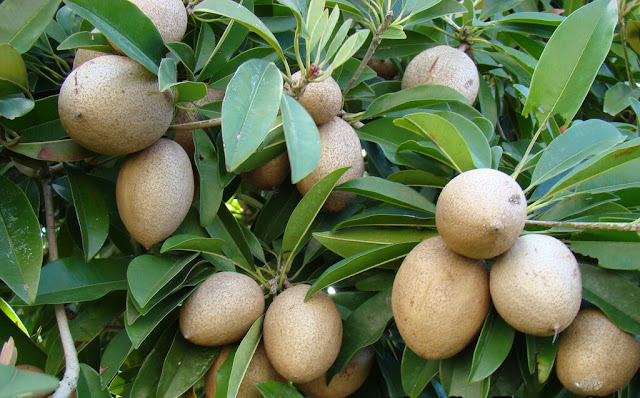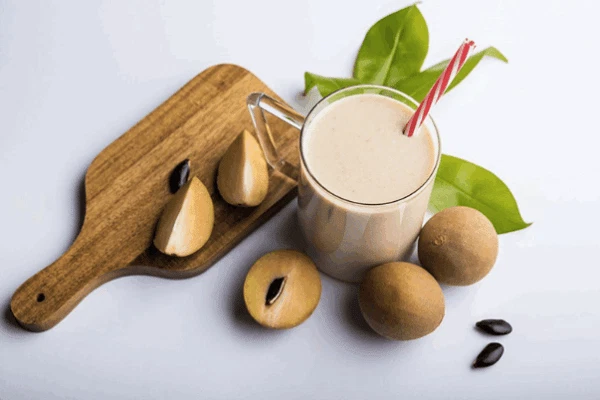Sapodilla is not only loved for its delicious taste and rich nutrition, but it is also a medicinal herb used to effectively treat digestive disorders and diuretics. Next, let’s learn more about the nutritional value as well as the characteristics and uses of this wonderful fruit.
Learn about Sapodilla
Other names: Sapoche, Sapodilla,
Scientific name: Manilkara zapota or Achras sapota l.
Medicinal name: Shell, seeds and green fruit – Cortex, Semen, et Fructus Manilkarae.
Family: Sapotaceae
Origin of Sapodilla
Sapodilla originated in South America, especially in Mexico. Over the years, this species has been transplanted all over the world, mainly in tropical regions. Currently, the tree is found in many different countries such as Thailand, Malaysia, Vietnam…
There is research that, because the species was introduced to our country from Thailand, this country is known as Siam. In addition, the shape of this tree is quite similar to the Persimmon fruit (genus Diospyros), so it is called Sapodilla.
Some characteristics of Sapodilla growth
- Planting soil: not too picky about soil. However, the tree cannot withstand waterlogging, so it needs loose, well-drained, nutrient-rich soil. Dry straw can be used to cover the base. In addition, the tree is salt-tolerant, so it can be planted in coastal areas.
- Temperature: Prefers tropical, hot and humid climates, suitable from 24-30 degrees Celsius, can withstand temperatures below 10 degrees Celsius. However, the tree cannot grow in arid areas.
- Humidity: Belonging to a moisture-loving tree species, the tree needs to be watered regularly in the early period (3 years) after planting. After that, the tree can be watered 2-3 times a week, depending on weather conditions and soil humidity. During the rainy season, to keep the tree healthy, pay attention to drainage and avoid waterlogging.
The main pests are aphids, manifested by a thin white layer attached to the leaf stalks and fruit stalks.
The seeds have a high germination rate (after 1 month). However, it is often grown by cuttings. Because when propagating by seeds, there will be a large degree of separation, the young tree will not retain the quality of the mother tree. When cutting, to achieve the best quality, choose branches with a lot of new sap, strong, not too old.
The yield is quite high and stable. Flowers and fruits are scattered throughout the year. However, there are 2 main seasons: spring-summer and summer-autumn. There are many varieties of Sapodilla.

Sapodilla is a familiar nutritious fruit.
Description of the whole Sapodilla tree
It is a large, woody tree, about 10-15 m high, perennial, with many branches. The trunk has a gray-brown, thick, rough bark, round pores, and contains a lot of white latex. The branches and young leaves are often covered with fine hairs, growing intertwined and crisscrossing each other.
Leaves are entire, glossy, thick, alternately arranged, concentrated at the top of the branches, elliptical or oval, 7–15 cm long, with smooth edges. The upper surface of the leaf blade is green and smooth, while the lower surface is paler and hairless. In addition, the leaves tend to grow concentrated at the top of the branches.
Flowers are solitary, white, bell-shaped, growing in the axils of the upper leaves, regular, bisexual. Usually 3-leaf pattern, sometimes 5-leaf pattern. Calyx 6-toothed, arranged in 2 rows, covered with yellow hairs. Corolla attached to ½, 6 petals, 6 stamens, many flat. Ovary 10-20 cells. Peduncle 1-2 cm long.
Large, juicy fruit, 4-8 cm in diameter, flattened ovoid, dark brown and shiny. The flesh of the fruit is reddish brown with a fine, sandy texture. There are 3-5 black, flat and shiny seeds in the fruit.
Medicinal parts, preservation
Sapodilla is a very popular fruit tree. With its sweet, aromatic taste, rich in fiber and nutrients, it can be used fresh or used to make smoothies.
In addition, the seeds, peel and green fruit of the tree are used as medicine.
In America, especially Mexico, people also harvest the sap (chicle) to make mint candy, chewing gum, cough medicine, digestive aid, or breath freshener. After taking the sap from the tree trunk, boil the sap and stir well to evaporate the water. While the sap is still hot, pour it into a wooden basin coated with soap so that the sap does not stick to the basin. Wait for a while, the sap hardens and weighs about 10kg.
Storage: The medicinal herb should be stored in a cool place, room temperature, avoiding direct exposure to sunlight.
Chemical composition and effects of Sapodilla
Chemical composition
According to many research documents, Sapodilla consists of the following components:
- Green fruit and peel contain 40% resin, 1.7% carbohydrates, 35% water and some other substances.
- The young bark contains a saponin (11.8%) and a little crystalline alkaloid called sapotin. The old bark contains tannin.
- The ripe fruit contains 0.4% protein, 9% glucid, 2.3% cellulose and 0.5% ash. The ash contains 46.8% calcium, 21.6% phosphorus, 7mg% vitamin C…
- The seeds contain 23% fatty oil and hydrocyanic acid.
- There are studies that have analyzed that this is a fruit rich in antioxidants and high in nutrients.
Specifically: 100g of Sapodilla fruit contains 1.10g of fat, 0.8mg of iron, 0.44g of protein, 60IU of beta-carotene, 12mg of phosphorus, 21mg of calcium, 0.037mg of vitamin B6, 0.02mg of vitamin B2, 0.252mg of vitamin B5, 14.7mg of vitamin C, etc.
In addition, the sweetness of the fruit is natural, with very little sodium, so it is very suitable for people with high blood pressure, heart disease, kidney disease, etc.
Effects of Modern Medicine
- Supports the treatment of high blood pressure: due to the Potassium component, which has the effect of lowering blood pressure.
- Highly antioxidant, rich in nutrients, prevents calcium deficiency and anemia in pregnant women. In addition, this fruit is very beneficial for the fetus, helping to prevent abnormalities and promote the development of the nervous system (because the medicinal herb contains folic acid, calcium, which helps regenerate new red blood cells and prevent fetal abnormalities).
- Supports digestive disorders, reduces diarrhea: Due to the polyphenols and tannins in the fruit, they have the ability to regulate intestinal activity.
- Sedative: Some preliminary studies show that the medicinal herb also has the effect of soothing and reducing pressure on the central nervous system. Therefore, it is very suitable for conditions of frequent insomnia, anxiety…
Traditional Medicine Effects
Sweet taste, cool properties.
Effects:
- The green peel and fruit can treat diarrhea, cholera, dysentery, etc.
- The green fruit is also used to detoxify when taking an overdose of laxatives or diarrhea.
- Seeds: have diuretic and cooling effects, support for urinary incontinence, fever, etc. Sapodilla seed extract is applied to the hair to maintain softness and reduce hair loss.
- Fruit: has cooling effects, produces body fluids, quenches thirst, is laxative, and prevents constipation, etc.
- Tree sap: is exploited in the chewing gum processing industry, etc.
In addition, in some localities, the fruit and young leaves of the Sapodilla tree can be crushed and applied to dog and cat bites to reduce swelling and pain.

Sapodilla smoothie is a delicious drink with high nutritional value.
How to use Sapodilla
Depending on the purpose of use, the medicinal herb can be prepared in many different ways, in the form of decoction, powder or eaten directly.
Dosage:
- Ripe fruit: 3 – 5 fruits/day, can treat constipation.
- Green fruit 15-20 g/day, supports the treatment of diarrhea.
- Bark: 15 – 20 g bark/day. Cambodians use bark to treat diarrhea because it contains tannin and fever in the form of a decoction of 6-12 g.
- Seeds: Diuretic effect, reduces fever. Be careful because high doses can be toxic (Grind 6 seeds into powder and drink with alcohol or boiled water each time).
Some remedies from Sapodilla
Treat digestive disorders, diarrhea
- 15-20g green fruit, add 200ml water, simmer until 100ml remains, divide into two doses per day. Drink 15 minutes after meals. Drink for 3-5 days.
- Or 15-20g bark, wash, add 250ml water, boil for 15 minutes until 100ml remains, divide into two doses per day.
Treat constipation, poor appetite, strengthen the spleen:
- Choose ripe Sapodilla fruit, eat twice a day, 2 fruits each time, continuously for several days. In case of severe constipation, you can eat 3-5 fruits/day, can be used directly or in smoothie form…
- Or Sapodilla leaves 20g, tangerine peel 10g, water 5g, boil 400ml of water until 150ml remains, one dose per day, divided into two doses. Use for 5 consecutive days.
Diuretic, fever reducer
- 5g of Sapodilla seeds, boil in water to drink, can add 100g of Bamboo leaves. Then, boil 450ml of water down to 150ml, divide into 2 times a day, drink while still hot.
How to recognize ripe Sapodilla
Sapodilla should only be eaten when it is ripe because then you can fully enjoy its deliciousness and nutrition. Moreover, when it is not ripe, the green fruit will contain a lot of sap.
- Color: The skin is yellow-brown, picked when it is old and almost ripe. The skin is yellow-green, usually “young”, and will not taste good.
- Shape: You should choose oval-shaped fruits with long bodies, so they will be sweet and delicious. Round fruits will have many seeds and are not as delicious.
To be sure, the persimmon is ripe, you can gently squeeze the fruit to see if it is still hard or soft. When you touch it, it feels soft and has a mild aroma on the outside, then the Sapodilla is ripe and can be eaten immediately.
Its flavor is similar to the smell of brown sugar, very fragrant and delicious.
Taboos
Allergy to any ingredient in the medicine.
Avoid eating too much unripe fruit because the tannin in the fruit can cause constipation.
Sapodilla is not only a nutritious and delicious fruit, but it also has many valuable effects in treating diseases. However, to be able to fully exploit the value of the medicine for health, you should consult a specialist or a doctor to control risks and unwanted effects.





